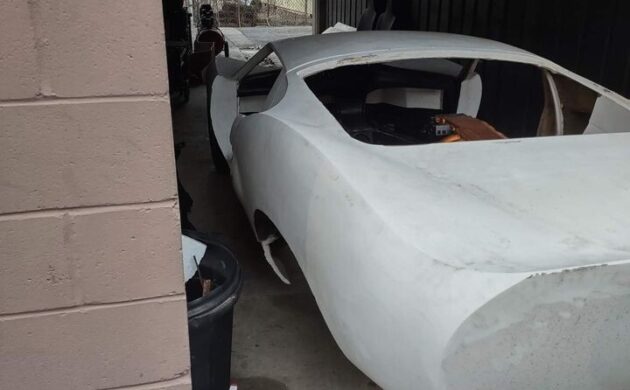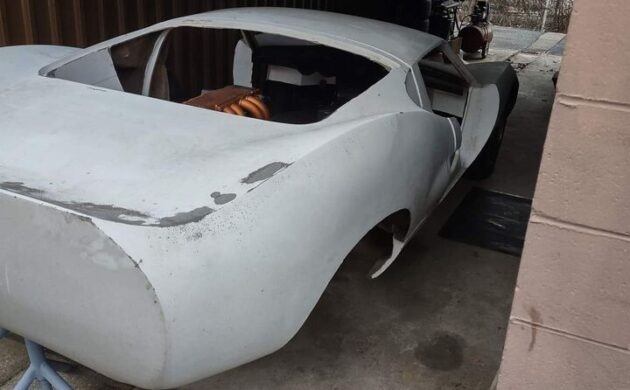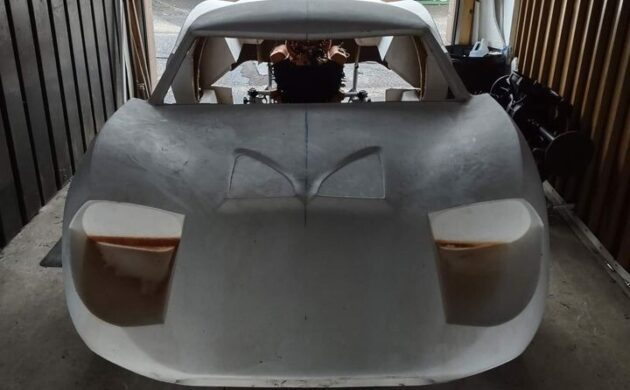Kit cars peaked in the 1960s, with many manufacturers producing bodies that an owner could drop onto a pre-existing production frame. More often than not, the frame hailed from the good people at Volkswagen, but some companies went their own way. One was Fiberfab, which produced its Valkyrie model from 1966. The company offered that model as a turnkey proposition, although a kit was available at roughly 10% of the price. This Valkyrie is little more than a body, but, as we will see, there is positive news for those wishing to recapture the wild days of the 1960s. This cool kit is listed here on Facebook in Mason, Ohio. The seller is asking $1,000 but may consider a trade for a small running car.
Fiberfab first appeared in 1964 in Palo Alto, California, with its bread-and-butter being fiberglass panels and other body enhancements for cars like the Corvette and Mustang. It rapidly branched out into kit car production, releasing the Valkyrie in 1966. The new model was based on Ford’s GT40 and was available in several forms. Buyers could walk into the factory and drive away in a complete car, or they could follow a more affordable route by purchasing a body and frame kit to undertake the build themself. That set Fiberfab apart from most others because they didn’t follow the tried-and-true path of bolting a body to a Volkswagen frame. The frame was bespoke but was fabricated to accept mechanical and drivetrain components from several sources. The company still exists, although it is now based in Washougal, Washington. This car is nothing but a fiberglass shell, meaning the buyer needs to make a few choices. None are likely to be cheap, and some may find the potential outlay too great to consider. Fiberfab still produces the frame, but a new one will cost the buyer $8,150. That is the first “ouch” with this project, but there’s more to come. While the body is complete, the new owner needs to purchase windows and seals. Doing so will lighten their wallet by a further $3,500. There is probably no workable way around the glass issue, but it could be worth seeing if it is possible to adapt the body to a VW frame. It could prove considerably cheaper, which may mean the difference between this being a viable project or finding its way into the “too hard” basket.
The bespoke frame was one unique aspect of the Valkyrie, but there was another that performance enthusiasts would have found equally important. Fiberfab produced several versions of the frame to utilize production components. Buyers could purchase a frame that would accept Corvair steering and front suspension or similar parts from a Mustang II. The car was designed to be mid-engined, which saw Fiberfab adapt a Corvair transaxle for the task. If a buyer had the cash, a frame was also designed to house a five-speed ZF transaxle. Since the company intended builders to slot a V8 into this car, the Corvair unit may have proved too fragile in extreme circumstances. The turnkey versions featured a 427ci V8, which would have made this rapid transport! If someone genuinely contemplates tackling this build and isn’t worried about bolting in a V8, a Subaru boxer engine would be lighter, and a turbocharged version could provide all the power most people would need.
If completed to a high standard as the factory intended, this 1960s Fiberfab Valkyrie could be a potent beast that will turn heads and set pulses racing when the driver presses the “loud” pedal. Achieving that goal is unlikely to be cheap or easy, and only a dedicated person with a healthy wallet will follow that path. However, a more affordable option could be to investigate whether this body could be mounted to a Volkswagen frame and running gear. The buyer will still face the considerable expense of purchasing glass, seals, and an interior, but the finished product will be significantly cheaper. Would you consider taking on this build?






First thought that comes to my mind is…paper tiger.
Had a couple of Porsche engines hanging around and almost bought one of these to build and put one into. Uncle Sam got in the way of that project but it would have been fun doing.
A former coworker has owned one of these for many years. The car is faster than ****. He built his with a custom CrMo frame, a Chevy 350 and a Corvair transmission. I’ve never driven it, but have been a passenger. Zoom is the main word that comes to mind. :)
Jim Hall’s Chaparral Group 7 Can-Am car used a Corvair AT, but don’t remember if he also used the diff. I wonder if that diff is as weak as everyone seems to think. Does anyone know?
You can bet Hall’s transmission didn’t have a single piece of the stock innards just like our Ford T4 full of huge gears that we run in our race cars. The only time we got close to one of the Hall cars the rear gear setup looked a lot heftier than in our Corvair Monza.
Don’t believe everything you read on the Internet… including parts of the story above. Adam writes great articles, but repeating incorrect info found online does not make it correct.
I Have owned and restored every Fiberfab Model, except the TD. copies, including 3 Valkyries., about 20 cars total, of the more than 300 I have bought sight unseen over the years. Some of them will be included on my continuing posting of the 300+ on my Facebook page.
Fiberfab’s ” bread and Butter” were bodies made for the VW Beetle Pan…NOT the Mustang or Corvette, Although they did sell some customizing panels for Detroit cars, the Aztec and Aztec II were it’s money maker, and all were VW Beetle based. A prolific number of other models followed, but is small quantities.. The GT body shown here, followed the Aztec II, and most were made as the GT12 for the VW Pan… a very few others were made for their 2×4 square tube chassis with Corvair rear engine and front suspension, and some Valkyries on a different 2×4 mid-engine chassis with Clark’s design modified transaxle for the 327 Chev V8, and Corvair front suspension.
It is not true that “The company still exists, although it is now based in Washougal, Washington” … The company in Washington is NOT the Fiberfab Company that built these bodies … it just uses the name.
The authentic Fiberfab Valks used the 327 Chev V8, which with Clark’s modification parts stood up well… They were not designed for a 427 Bigblock.
Back 10 years ago, the Valk’s were hot items, and I bought and sold 3,. Without better pictures, I can’t tell if this is a GT12 ( VW pan) or the GT Corvair they offered on a tube frame. but it does not look like e Valkyrie which being mid-engine has a longer wheelbase mid-engine chassis, so the rear wheel arc is further back than appears in these pictures.,
***** GT12 and Corvair bodies are for REAR engine aplications, and do NOT fit a mid-engine V8 Valkyrie chassis … so do diligence on this one,
*due
For me as I have helped build a Jamaican and a Valkyerie and that company could have been a huge success if they had only hung the doors and put in the door locks and side windows. While it can be done it is very time consuming and far beyond the abilities of the average builder and I would include most automotive shops.
I can say that for the time and even today these are very beautiful cars and they use a great deal of standard parts The rear window is an early fast back mustang window and I forget what the front window is. In truth I would think that it would be best to build a custom frame for this car. There are replica tube frames being built for LOTUS EUROPA’s and that might be a good place to start. In many ways this is a much more powerful version of a Europa that looks far better.
For what he has the price is right if even a little low as far as I am concerned. To who ever buys this unless you have a group of motor head friends to help you and know a couple of really good fabrication shops you are in for a world of hurt. BUT get it done and you will have something amazing to drive that you will have almost no chance of passing you by on any road. The Fiberfab cars had a balance of design that almost no other kit company possessed. They are flat beautiful when finished properly but just know that the amount of work that you think it might take and then multiply by between 4 and 10 and the same goes for the cost.
Is it worth it. Depends on the person but if you are diligent and thoughtful you will have something breathtaking and no new Ferrari, Lambo, Aston or Corvette can compete with. Those owner just purchases their cars YOU BUILT YOURS. That difference is huge in terms of respect.
i had i piece Avenger (they made a 1 piece a 2 piece and a 3 piece ) and the glass for both The Avenger and Valkyrie was all the same. The windshield was a Corvair unit, and the side windows were Ford Ltd with wind wings or custom i piece glass. The 1 and 2 piece bodys were very good looking but the 3 piece not so much. This car to me looks more like an Avenger based on what ooks like a short heel base
i had i piece Avenger (they made a 1 piece a 2 piece and a 3 piece ) and the glass for both The Avenger and Valkyrie was all the same. The windshield was a Corvair unit, and the side windows were Ford Ltd with wind wings or custom i piece glass. The 1 and 2 piece bodys were very good looking but the 3 piece not so much. This car to me looks more like an Avenger based on what ooks like a short heel base
@Dave at old school restorations,
Hey Dave,
Thanks for your input. I believe you covered good information regarding the company as well as the various models that were offered. It’s always humorous to hear the negative comments about the Fiberfab products, especially from people who dwell on negative information. If one follows the original plans for the GT-12 Avenger build, you will be guided by a step-by-step through the entire process. I always hear complaints about how hard it is to hang the doors and side windows in these Avengers. Not so. The door hinges (upper and lower) called for sourced ‘65 mustang steel. The Lexan (curved one piece side windows) ride in sourced and complete ‘66-67 V.W. regulator assembly’s. The weatherstripping for the sides were sourced Ford LTD. The front windshield was sourced from a mid ‘60’s Corvair. The rear glass was sourced from a 1965 fastback Mustang. Voilà! The difficult stuff solved. I still drive an early one-piece Avenger. I chose to match it up with a 1971 V.W. I.R.S. pan. All of the essentials are already in place. For the power source is a stroked 2300cc air-cooled engine (approximately 150hp), coupled to the original 4spd.(‘71) gear box. I own some cool and unique vehicles, but this humble kit still delivers an old school and thrilling driver experience like no other…Bud was a clever engineer. He had the foresight to use sourced parts from wrecking yards so the complete build was very affordable for the D.I.Y.‘Dr
One other add:
The outer door handles, if you chose that sleek race look, were sourced AMC units instead of later model protruding styles. If you think about it Bud Goodwin
had figured in all of the proper fitment issues from multiple sources without cutting up and destroying the intended style of the shaped car…